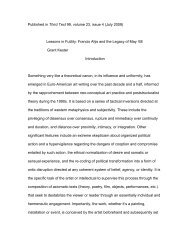Old Masters and New Lessons - Grant Kester
Old Masters and New Lessons - Grant Kester
Old Masters and New Lessons - Grant Kester
You also want an ePaper? Increase the reach of your titles
YUMPU automatically turns print PDFs into web optimized ePapers that Google loves.
the vantage point of a transcendent greater good.(23)<br />
Although Kant is concerned to differentiate aesthetic judgment from moral judgment by<br />
virtue of its non-instrumental or disinterested character, the very experience evoked by the<br />
aesthetic, the intuition of a universal voice, clearly has moral <strong>and</strong> political implications about<br />
which one could hardly remain indifferent. It is, after all, the aesthetic that claims to reconcile the<br />
purely subjective experience of beauty with the "objective" conditions necessary for political<br />
discourse <strong>and</strong> will formation. The unresolved relationship between the moral <strong>and</strong> the aesthetic in<br />
Kant's philosophy is marked by his recourse to a poetics of ambiguity. Although there is no<br />
causal relationship or "intrinsic affinity" (innere Affinitat) between morality <strong>and</strong> taste, it is<br />
nevertheless the case that our sense of beauty is provided with a form of moral "guidance"<br />
(geleitet, a word that also has the connotation of a military escort [Ak298]). Thus, despite Kant's<br />
insistence on the neutrality of aesthetic judgment, there is clearly an active moral <strong>and</strong><br />
pedagogical element at work: the aesthetic "teaches us to like even objects of sense freely"<br />
(Ak354), <strong>and</strong> in the act of experiencing beauty we are conscious of the fact that our mind is<br />
"being ennobled" (Veredlung [Ak353]).(24)<br />
This ambiguity between the moral <strong>and</strong> the aesthetic is characteristic of what philosopher<br />
Anthony Cascardi has termed the tradition of "aesthetic liberalism."(25) It also marks Hickey's<br />
account of a "rhetorical" beauty.(26) There are two components of Hickey's analysis that are of<br />
particular relevance here. First is his commitment to the "work of art" as a specifically privileged<br />
vehicle for inducing an "aesthetic" awareness, defined as a mode of cognition that provides a<br />
conduit between somatic experience (the felt pleasure of beauty) <strong>and</strong> a ground for<br />
intersubjective communication. This conduit itself has a highly developed symbolic value, <strong>and</strong>,<br />
although it is often only vaguely defined, it typically makes reference to some form of social or<br />
political consensus (in Hickey's case "democracy"). Second, the experience of the work of art is<br />
understood as a paradigm for the construction of an exemplary subjectivity. This is an essentially<br />
private encounter between the viewer (defined as a monadic subject) <strong>and</strong> the artwork (as the<br />
material expression of another monadic subject), which must remain free of any external<br />
"mediation." It is this belief in an unmediated, <strong>and</strong> essentially private, encounter that allows<br />
Hickey to ignore any contextual distinctions between, for example, the market conditions of the




